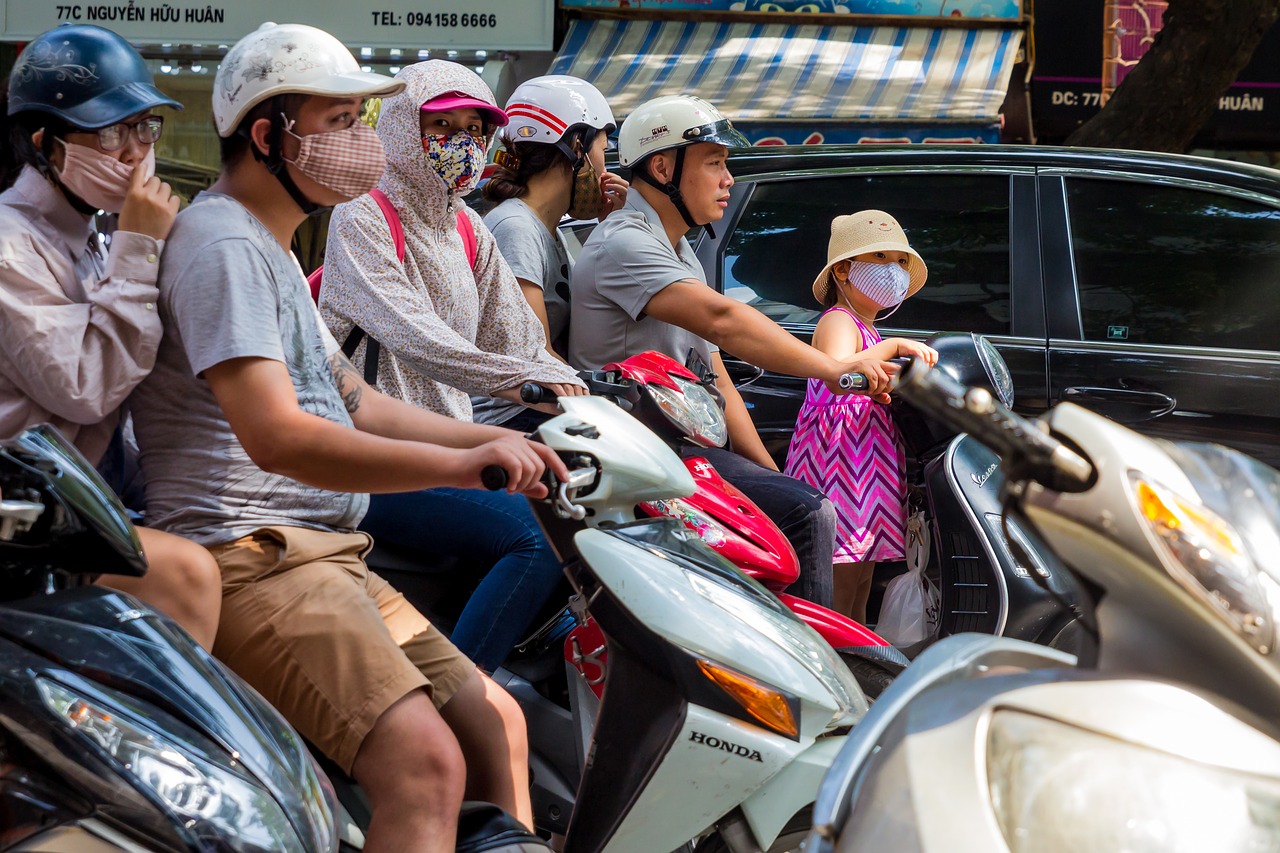
How Your Motorbike Pollutes
When an engine is running, it looks like this:

Blue is a gas-air mixture, red is an exploding gas-air mixture, and black is exhaust
In many places around the world, the majority of the population likes the idea of saving money, and therefore puts off the amount of money and time spent on the maintenance of their vehicles.
We’ve seen a lot of motorbikes that have halted due to their owners completely forgetting to change oil.
Motorcycles and scooters have worse emissions than cars! Can you believe it?!
This is because they have worse pollution control standards, so although they emit less CO2, the other greenhouse gasses they emit count for more than the CO2 emitted by cars. Even though two-wheelers are better than single-driver cars in urban areas (slower speed zones), they are far worse on highways.
Comparing a single driver two-wheeler to a full car of course shows that a car emits less per person.

Amount of Car VS Motorcycle Pollution in grams of CO2 source.
Looking at the amount of emissions produced in manufacturing, surprisingly, a $15,000 car VS a $15,000 two-wheeler, two-wheelers produce a lot more CO2 than cars. This is due to the auto industry improving emissions control technologies while the motorcycle industry has not. Overall, cars have both more sophisticated fuel systems and better emission controls than motorcycles.
Anyways! Back to how your motorbike is polluting the environment.
First of all, motorbikes produced in Asia have extremely little regard to emissions. There are no stringent emissions testing before they are sold. Second, motorbikes and scooters are being produced for as low as possible. People want fast and strong vehicles, not those that have the environment in mind. Third, people only replace things when they break. A lot of scooters don’t have oil lights, so forgetting to change oil, or simply leaving it too long can really harm the environment and people living in it.
Fuel Quality:
It is widely known that regulations for the quality of fuel are lower in many developing countries in comparison to those in industrialized nations.
Estimates indicate that there are currently about 1.2 to 1.3 million automobiles and 33 million motorbikes in Vietnam. With Vietnam’s rapid urbanization and sustained high economic growth, these vehicles are expected to increase substantially in the near future. The vehicle emissions and fuel quality roadmap can greatly ensure that future automobiles and motorcycles will be cleaner.
Maintenance
The frequency at which we maintain our motorbikes is extremely important. You should check your motorbikes manual (online if not on paper) to see how often you should do standard maintenance.
For example, you should change oil every 1000 kilometers. You should inspect (clean, adjust, lubricate, or replace if necessary) the fuel line, throttle operation, spark plugs, and engine idle speed every 4000 kilometers. Beware that this schedule is for a very simple semi-automatic. For older bikes, you should maintain more frequently, and for newer bikes, you should check your manual.
Brakes, oil and tires the 3 most important things to maintain on your motorcycle.

Brakes
Brakes should be replaced as soon as you feel like you cannot brake as well as you used to, or as soon as you hear a scratching sounds coming from them. Disc brakes start to hiss when you are not using them at all if they’re getting too thin.
Oil
The right type of oil for your engine should be used. Your manual should state if your bike uses synthetic or semi-synthetic oil. The higher quality (and thus more expensive) oil you use should ensure that your engine lasts a long time.
Tires
Your tires are the only thing that connects you to the tarmac. To make sure your tires are good, inspect the treads for depth. Your front tire will be used more quickly (and thus should be replaced more often) because you turn it more frequently. Motorcycle/scooter tires flatten in the middle as they’re used more, which makes it more difficult to make turns without slipping out.
Air Filter
In polluted areas, the air filter on your bike needs to replaced more often than on clean roads. Extreme amounts of dust are filtered by your air filter, and the filter needs to be cleaned or replaced to stop from dust entering into the engine.
Chain/Drive Belt
Chain’s on semi-automatic or manual motorbikes and scooters need to be maintained regularly. They should be lubricated and kept tight. In automatic scooters, you have to monitor the rubber belt that turns the wheel. In most bikes it is located under the air filter. The drive belt doesn’t need to be replaced frequently, unless it is showing cracking (around every 4000km). If it is slipping (when accelerating you don’t move forward like you used to), it needs to be replaced. There are variator rollers (or ceramic bearings) that allow the drive belt to move faster and slower depending on your required acceleration. These rollers allow the belt to move smoothly, and they need to be replaced more frequently than your belt. Inside this same housing is your clutch. A clutch has pads that wear down over time. It is an expensive part but you do have to change this to make sure you can accelerate as you’re supposed to. You can see all of this in the following link that shows how to replace everything in your variator housing.
Shocks
For a comfortable ride, your shocks need to be maintained every 10,000km or so by replacing the oil in the shocks. You could also buy a new pair of shocks after your bike has ran 30,000km or so with the stock ones. Newer shocks have better mechanics and make for a much smoother ride.
More on Fuel in Vietnam
Euro 4 emission standards VS Euro 5 emission standards:
Euro 3 standard fuel is still in circulation in Vietnam. It is named RON 92 petrol. In comparison, the newer Euro 5 standard Biofuel requires better petrochemical filtering technology, and therefore is more expensive.
The European Emission Standards define the acceptable limits for exhaust emissions of vehicles in the EU. The stages are typically referred to as Euro 1, Euro 2, Euro 3, Euro 4, Euro 5 and Euro 6 for Light Duty Vehicle standards.
In Vietnam, under the September 1st, 2011 roadmap, automobiles are required to comply with Euro 4 emission standards by January 1, 2017 with further tightening to Euro 5 emission standards starting January 1, 2022. Vietnam will skip Euro 4 standards and move ahead to Euro 5 Standards in 2022.
Motorcycles manufactured, assembled or newly imported will be required to comply with Euro 3 emission standards beginning January 1, 2017.
Phan Quynh Nhu, Secretary-General of the Vietnam Clean Air Partnership (VCAP), says that the leading cause of air pollution in Vietnam is from transport, particularly engine-run vehicles, which led to the need for strict limits on emissions. (Source)
Problem
The problem of air pollution in cities of newly developed and developing countries is mainly created by a rapid growth in the use of motorcycles and passenger cars as traffic tools. In comparison to passenger cars, information about motorcycles’ hardware controls on emissions, including catalyst, engine design, and fuel composition, is scarcely available. Motorcycle tail-pipe emissions are affected by fuel type, engine type, and catalyst. Regulatory agencies, motorcycle industries, and fuel industries should further explore optimal control strategies to reduce motorcycle-related air pollution. (Source)
Scandal
In 2015, the Volkswagen emissions scandal involved revelations that Volkswagen AG had deliberately falsified emission reports by programming engine management unit firmware to detect test conditions, and change emissions controls when under test. The cars thus passed the test, but in real world conditions, emitted up to forty times more NOx emissions than allowed by law.[22] An independent report in September 2015 warned that this extended to “every major car manufacturer”,[23] with BMW, and Opel named alongside Volkswagen and its sister company Audi as “the worst culprits”,[23] and that approximately 90% of diesel cars “breach emissions regulations”.[23] Overlooking the direct responsibility of the companies involved, the authors blamed the violations on a number of factors, including “unrealistic test conditions, a lack of transparency and a number of loopholes in testing protocols”. (Source)
Solution
The only good way forward is to take responsibility for manufacturing, owning, and taking care of our vehicles so that the environment is not harmed.
